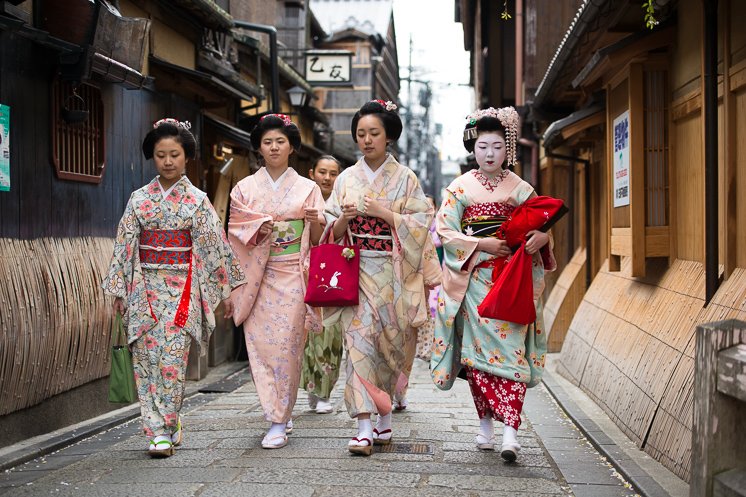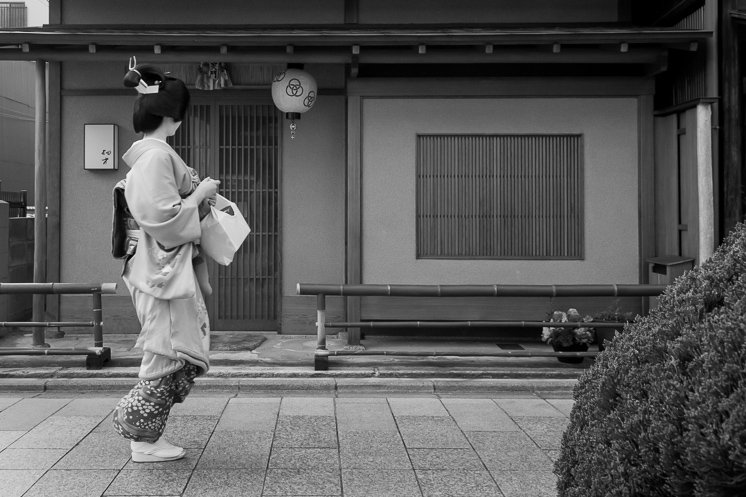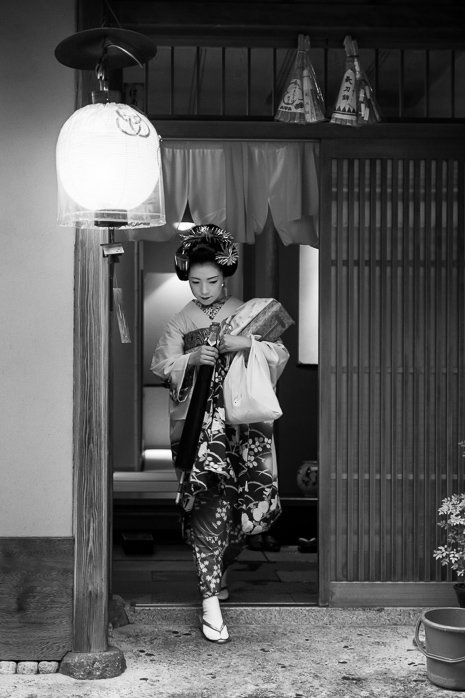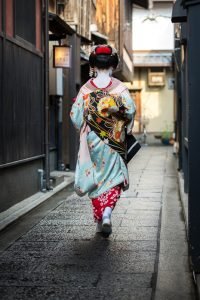Within the rich cultural history of Kyōto, the roles of Maiko and Geiko stand out as central figures. These terms represent the two main stages in a geisha’s professional journey. A Maiko is often a younger individual in the early phase of her career, while a Geiko is a more experienced and fully trained geisha. The differences between them are not just about age or skill level but involve distinct training experiences, duties, and cultural meanings.
For those aiming to truly understand and appreciate the art and tradition of these entertainers, recognizing the specific attributes and roles of both Maiko and Geiko is crucial. Both contribute significantly to the continuation and growth of traditional Japanese arts and entertainment, and a deeper grasp of their unique positions provides a clearer view of the geisha culture and its significance today.

Definition and Origin
The term Maiko (舞妓) can be broken down into its kanji components: “mai” (舞) meaning “dance” and “ko” (妓) signifying “child” or “girl.” Thus, Maiko can be translated as a “dancing child” or “dancing girl.” This nomenclature highlights their primary role and focus on dancing during their training phase.
Generally, a Maiko’s age spans from 15 to 20 years. This phase signifies an early yet vital stage in their journey toward becoming a Geiko. Maikos embark on their training right after middle school, entering a unique environment distinct from their contemporaries. Here, they learn the many arts essential to the geisha tradition.
The Maiko holds an esteemed position within geisha culture. Their youthful aura combined with unwavering dedication stands testament to the discipline and persistence the profession demands. They are not merely learners but also the torchbearers of the future of geisha culture, ensuring the seamless transition of age-old traditions and arts to subsequent generations. Their vibrant performances often serve as the introductory gateway for many into the captivating realm of geishas.

The term Geiko (芸妓) is derived from two kanji characters: “gei” (芸) which translates to “arts” and “ko” (妓) meaning “child” or “girl”. In essence, a Geiko can be understood as an “art performer” or “artist girl”. While the term “geisha” is commonly used across Japan, in Kyōto, the historical heartland of this tradition, the term Geiko is preferred.
After years of rigorous and disciplined training, a Maiko transitions into becoming a Geiko. This evolution signifies that the individual has reached a level of mastery in various arts essential to the profession, from traditional dance and singing to the art of conversation. By this stage, they are no longer apprentices but full-fledged geisha, equipped with the skills, knowledge, and experience to carry forth the cultural legacy.
While both Maiko and Geiko are integral parts of the geisha tradition, their roles and responsibilities differ in several key ways:
The world of Geiko and Maiko is not just differentiated by roles and responsibilities, but also by distinct visual cues that reflect their stage in the geisha journey. These differences, evident in their attire, makeup, and accessories, serve as markers of their progression and expertise. For those keen on understanding and recognizing these nuances, here’s a primer:
Both Maiko and Geiko wear kimonos, but the styles and patterns differ:
The makeup worn by these artists serves as another clear visual indicator:
Hair ornaments and other accessories are pivotal in distinguishing between Maiko and Geiko:
For those eager to delve even deeper into the intricate details that set Maiko and Geiko apart, have a look at our post “Maiko and Geiko: 10 Ways to Tell Them Apart”, where we explore further nuances and subtleties of their appearances.
The transformation from Maiko to Geiko is not merely a change in title; it’s a culmination of years of rigorous training, dedication, and adherence to traditional practices. This journey is marked by the acquisition of various skills and participation in specific ceremonies and rites of passage, all aimed at refining their art and elevating their status within the geisha community of Kyōto.
Both Maiko and Geiko undergo extensive training, but the focus and depth differ based on their stage:
Two pivotal rites of passage in a Maiko’s life are the Mizuage and the Erikae.

Interestingly, there isn’t a fixed time period for the Maiko phase. The decision to transition to a Geiko is based on personal readiness, as determined by her sensei (teachers in arts and performance) and the Okaasan (meaning ‘mother’ and referring to the proprietress of the okiya, or geisha house where she resides). Factors like a Maiko’s demeanor and aptitude in the arts play a significant role. For example, a Maiko with a more youthful, playful, and “kawaii” demeanor might remain in the Maiko phase longer, as her qualities align well with the expectations of a Maiko. Conversely, someone with a more mature, sophisticated, and elegant demeanor might transition to the Geiko phase earlier.
These ceremonies not only highlight a Maiko’s growth and progression but also underscore the deeply rooted traditions and practices that govern the world of the geisha.
Hanamachi (花街), directly translating to “flower towns,” are the traditional geisha districts located in historic cities, with Kyōto being one of the most renowned. These districts have flourished for centuries as hubs of refined entertainment and culture. Both Maiko and Geiko have distinct roles and functions within the Hanamachi, shedding light on the meticulous workings of the geisha world.
The Hanamachi, in essence, are more than just districts; they represent environments that preserve and nurture the age-old traditions of the geisha ethos. The roles Maiko and Geiko play are crucial in ensuring the continuity and vibrancy of this unique cultural realm.
As with many traditional practices around the world, the roles and relevance of Maiko and Geiko in today’s Japan have witnessed a considerable transformation. Yet, while the landscape around them has evolved, the essence of their artistry and the spirit of perseverance remain firmly intact.
Despite these challenges, the unwavering commitment of the Geiko, their Okaasan and the larger community ensures that this rich tradition continues to flourish. Their resilience is a testament to the deep-rooted value and respect that the geisha culture holds in Japanese society, even in the face of a rapidly changing world.

Maiko and Geiko, though distinct in their roles and stages, both encapsulate the timeless beauty and sophistication inherent in Japan’s cultural fabric. Their dedication to their craft, the meticulous attention to detail in their attire, and the grace of their performances are not mere entertainment. They are, in fact, moving reflections of Japan’s historical and cultural continuum.
It’s essential for enthusiasts, scholars, and even casual observers to recognize and respect the depth of these roles. While the surface may present striking visuals and performances, the depth holds a treasure of history, discipline, and dedication.
Intrigued by the nuanced lives of Maiko and Geiko? This article is just a fragment of our all-encompassing examination of geisha culture.
For a complete journey through this intricate world, check out the comprehensive list of articles in our foundational guide on geisha culture.
My series “Moments of Beauty I” captures timeless moments in Kyōto’s geisha quarters, known as hanamachi. I created this series during a year-long stay in a small, traditional house located between two of the most beautiful hanamachi in Kyōto. As I passed through these neighborhoods daily, I became enamored with the aesthetic of the traditional Kyōto townhouses, called kyō-machiya, and the daily life within the geisha quarters.
As I spent more time exploring the streets on foot and by bike, I began to regularly see geiko (the term used for geisha in Kyōto) and maiko (apprentice geiko) going about their daily activities. The sophisticated and elegant way in which they move and behave, almost gliding along the streets in full attire, captivated me. These moments were like watching a play unfold before my eyes, like a scene from another era taking place in the present. These short, spontaneous “plays” take place daily without an audience and without following a fixed schedule. If you happen to be in the right place at the right time, you have the opportunity to witness and enjoy them.
With my photography, I aimed to capture these “plays” by setting the stage with the beautiful kyō-machiya architecture in the background, and waiting for interesting moments to happen within the frame. I often waited for hours without any results, but it was all worth it when everything came together for that one moment of fleeting beauty, only to disappear again a few seconds later.
I created this series in black and white, to keep a balance between the houses and the maiko and geiko, without the colorful kimono overpowering the architecture in the background. This also gives the pictures a sense of timelessness. Most of the scenes I photographed happened the same way 300 years ago as they are happening today. To me, there is a special beauty in the idea of moments that are fleeting but get repeated for hundreds of years through lived tradition.
It is my hope that my series “Moments of Beauty I” will transport the viewer to the streets of Kyōto’s hanamachi and allow them to experience the same sense of wonder and appreciation that I felt while creating it.
My series “Hanamachi I – Moments of Beauty” captures timeless moments in Kyōto’s geisha quarters, known as hanamachi. I created this series during a year-long stay in a small, traditional house located between two of the most beautiful hanamachi in Kyōto. As I passed through these neighborhoods daily, I became enamored with the aesthetic of the traditional Kyōto townhouses, called kyō-machiya, and the daily life within the geisha quarters.
As I spent more time exploring the streets on foot and by bike, I began to regularly see geiko (the term used for geisha in Kyōto) and maiko (apprentice geiko) going about their daily activities. The sophisticated and elegant way in which they move and behave, almost gliding along the streets in full attire, captivated me. These moments were like watching a play unfold before my eyes, like a scene from another era taking place in the present. These short, spontaneous “plays” take place daily without an audience and without following a fixed schedule. If you happen to be in the right place at the right time, you have the opportunity to witness and enjoy them.
With my photography, I aimed to capture these “plays” by setting the stage with the beautiful kyō-machiya architecture in the background, and waiting for interesting moments to happen within the frame. I often waited for hours without any results, but it was all worth it when everything came together for that one moment of fleeting beauty, only to disappear again a few seconds later.
I created this series in black and white, to keep a balance between the houses and the maiko and geiko, without the colorful kimono overpowering the architecture in the background. This also gives the pictures a sense of timelessness. Most of the scenes I photographed happened the same way 300 years ago as they are happening today. To me, there is a special beauty in the idea of moments that are fleeting but get repeated for hundreds of years through lived tradition.
It is my hope that my series “Moments of Beauty I” will transport the viewer to the streets of Kyōto’s hanamachi and allow them to experience the same sense of wonder and appreciation that I felt while creating it.